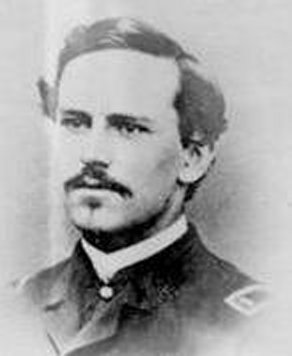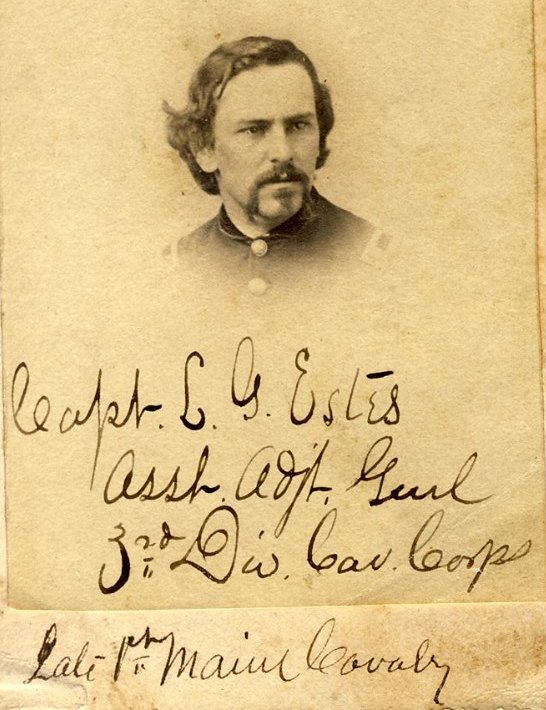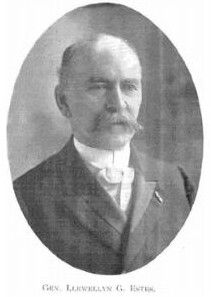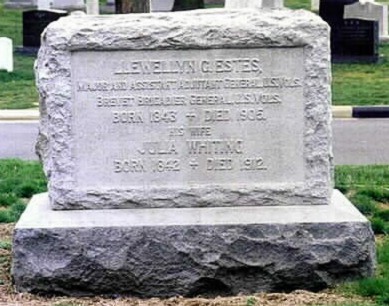

Lewellyn Garrish Estes With a good Welsh name, Estes was born at Old Town, Maine, in December 1843.
He was 17 when—taking advantage of his father’s absence from home—he enlisted in Company A of the 1st Maine as sergeant in October 1861. He gave his age as 21.
Making a quick rise, he was commissioned 1st lieutenant on March 24, 1862. During the regiment’s first campaign in the Shenandoah Valley, he was wounded at Middletown on May 24, 1862. While the regiment was involved in Pope’s withdrawal beyond the Rappahannock he was captured near Warrenton on August 22, 1862, and spent time in prison until he was exchanged and returned to the regiment on December 21.
In March 1863 the 1st Maine was called on for a brigade staff officer, and Lieutenant Colonel Smith suggested to Colonel Douty, “There’s Estes; he won’t work in harness,” so Estes was appointed acting assistant adjutant general of Kilpatrick’s 1st Brigade of the Third Division. During Stoneman’s Raid in May 1863, Kilpatrick’s Brigade was sent to the east and proceeded down the neck to Gloucester. At one point Estes volunteered to carry a message back. He and his orderlies were captured, but then captured their captors and brought them in to Kilpatrick.
Estes was actively engaged at Brandy Station and the advance to Upperville as Kilpatrick’s principal staff member, and he became Third Division a.a.a.g. when Kilpatrick was promoted to brigadier general and given command. At Gettysburg on July 2 he led a wild saber charge through Hunterstown. The next day, he joined in the unfortunate charge that Kilpatrick ordered Gen. Farnsworth to make on the left, emerging safely, unlike Farnsworth. Later in the campaign he captured a Confederate battle flag, probably during Kilpatrick and Custer’s charge at the Battle of Falling Waters on July 14.
Promoted to captain of Company A on June 18, 1863, he remained on detached duty and was officially separated from the 1st Maine when he was assigned as an assistant adjutant general of volunteers in December 1863—when he turned 20. This cdv was probably taken about that time, and he also appears in a photograph of Kilpatrick sitting on the porch of Rose Hill, Kilpatrick’s headquarters at Stevensburg.
During the Kilpatrick-Dahlgren Raid, Estes seized the telegraph station at Beaver Dam before a warning could be sent to Richmond. He was at the very front when Kilpatrick got cold feet and decided not to dash into Richmond. And as Kilpatrick’s column retired down the Peninsula, Estes commanded his old company of the 1st Maine in a charge on the Confederate cavalry that stalked the column.
In April 1864 Estes went with Kilpatrick to the west and became adjutant general of cavalry in the Military Division of the Mississippi. Kilpatrick’s cavalry was sent with Gen. Howard’s infantry to cut the railroads into Atlanta in August 1864. As they approached the Flint River near Jonesboro, Estes was commanding the cavalry brigade on the right flank. When Howard asked him to drive the Confederates across the river so the infantry could obtain water, Estes scattered them with a mounted charge, then offered to take the bridge. Dismounted, he led two companies across the stringers of the dismantled bridge to secure the crossing.
Commissioned major in September 1864, he was heavily engaged in the running battles with Wheeler’s and Hampton’s cavalry across South and North Carolina. In November and March, Wheeler and Hampton twice overran Kilpatrick’s camp and Kilpatrick fled in his drawers. Estes escaped capture because, rather than staying the house with Kilpatrick, he bunked in the ambulance that carried his adjutant general papers. In March 1865 he was commissioned lieutenant colonel and colonel by brevet.
During the negotiations between Sherman and Johnston that resulted in the surrender in late April 1865, Estes was a messenger. During the interim, he seems to have emulated his commander by taking a female companion, who dressed in male clothing and called herself “Frank.” As adjutant general of western North Carolina, he supervised activities in 41 counties of North Carolina from April through September 1865.
Estes was breveted brigadier general on September 30, 1865, and resigned from the army, settling in North Carolina. In 1894 he was awarded a Congressional Medal of Honor for his action at the Flint River. Llewellyn G. Estes died in 1905 and is buried at Arlington National Cemetery.
Awarded the Medal of Honor for leading a charge over a burning bridge at Flint River, Ga., 30 August 1864. Medal issued August 29, 1894.
Estes died on February 1, 1905 and was buried in Section 3 Grave 1437 of Arlington National Cemetery.
His wife, Julia Whiting Estes (1842-1912), is buried with him.


